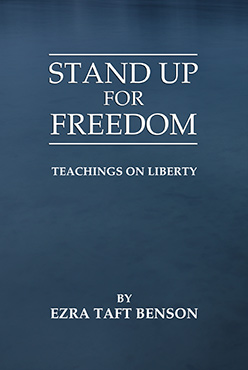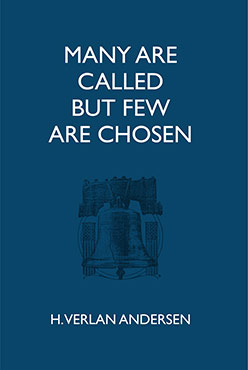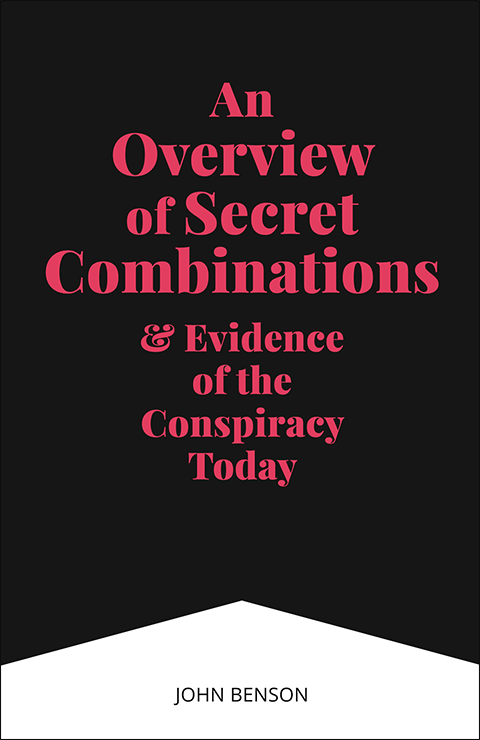The Supreme Court, Then and Now
W. Cleon Skousen. The Supreme Court, Then and Now. [From Law & Order, January 1977].
Just across the park from the Capitol building in Washington, D.C., is a distinctive structure of white marble with giant pillars on which is inscribed the words, “Equal Justice Under Law.” This is the Supreme Court of the United States of America.
Within the labyrinths of this majestic temple of justice, nine men pass judgment on everything from a petition on behalf of a mass-murderer incarcerated in Illinois to a writ of appeal involving billions of dollars in property rights, all of which hang precariously in the balance as the court ponders the application of certain legal technicalities.
Many Americans haven’t the faintest idea of the monumental impact which the solemn pronouncements of this court have on their daily lives.
The Court’s Unique Role as the “Guardian of the American Way”
The American life-style emerged from the aspirations of the early founding fathers to create a new kind of civilization. Beginning with a population of nearly four million human beings, they thought they could contrive a political structure which would provide order and justice but operate under such strict limitations that it could not trample on the freedom and natural rights of the people. The fact that it worked so well and eventually became a citadel of power and prosperity for over two hundred million people was primarily due to a unique political idea — the idea of dividing governmental services according to the function they best served. Never before had a nation deliberately fragmented its sovereign authority and set up a system of checks and balances designed to compel each branch of government to stay in its own back yard. This became known as “the American way.” As Thomas Jefferson said:
“The way to have good and safe government, is not to trust it all to one, but to divide it among the many, distributing to every one the functions he is competent to (perform)…. What has destroyed liberty and the rights of man in every government which has ever existed under the sun? The generalizing and concentrating all cares and powers into one body.”
It was recognized from the beginning that the genius of the American system depended almost entirely on strong local self-government and preventing a strong centralized authority from developing in Washington which would be too powerful to control. It was this danger which almost resulted in several of the States refusing to adopt the Constitution. To reassure them, James Madison, the so-called “father of the Constitution,” wrote:
“The powers delegated by the proposed Constitution to the federal government are few and defined. Those which are to remain in the State governments are numerous and indefinite. The former (the federal government) will be exercised principally on external objects, as war, peace, negotiations, and foreign commerce…. The powers reserved to the several States will extend to all the objects which, in the ordinary course of affairs, concern the lives, liberties, and properties of the people, and the internal order, improvement, and prosperity of the State.”
But who would act as the great arbiter or enforcement agency to see that each department of government stayed within its proper boundaries? This delicate and difficult task was assigned to the United States Supreme Court. The judiciary was to make certain that no man or combination of men with the ambitions of a Caesar rose up to seize power.
Thomas Jefferson Saw a Potential Danger
It did occur to Thomas Jefferson, however, that the Court, itself, might someday become the wife of Caesar and use its unique and powerful position of trust to gradually unify all political authority and destroy the very system of separation of powers between the States and the federal government which the highest court in the land was set up to preserve and protect. For nearly a hundred years very few people gave much credence to the warning of Jefferson because the Court functioned with admirable restraint for several generations. However, in this generation more and more Americans (certainly law enforcement officers) have had numerous occasions to recall Jefferson’s words written shortly before his death in 1821:
“It has long, however, been my opinion, and I have never shrunk from its expression … that the germ of dissolution of our federal government is in the constitution of the federal judiciary; an irresponsible body, (for impeachment is scarcely a scare-crow) working like gravity by night and by day, gaining a little today and a little tomorrow, and advancing its noiseless step like a thief, over the field of jurisdiction, until all shall be usurped from the States, and the government of all be consolidated into one. To this I am opposed; because, when all government, domestic and foreign, in little as in great things, shall be drawn to Washington as the centre of all power, it will render powerless the checks provided of one government on another, and will become as venal and oppressive as the government from which we separated.”
Structure of the Federal Judiciary
Even the founding fathers knew that the unprecedented role of the federal judiciary would have to be developed gradually on the basis of future experience. Consider, for example, the singular fact that never before in history had a legislative body allowed its acts to be reviewed by a court as to their constitutionality. Nevertheless, the notes on the Constitutional Convention reveal that this was contemplated by the founders long before Chief Justice Marshall announced this doctrine from the bench. There were also many other aspects of the federal judiciary which were experimental in nature and therefore the founders described this particular department of government in broad, general terms so that the details could be supplied by Congress as future circumstances dictated. Here is the simple language in the Constitution which refers to the federal judiciary:
The judicial power of the United States, shall be vested in one Supreme Court, and in such inferior Courts as the Congress may from time to time ordain and establish. The judges, both of the supreme and inferior Courts, shall hold their offices during good behavior, and shall at stated times, receive for their services a compensation which shall not be diminished during their continuance in office. (Article III, Sec. 1)
Several things should be noted in this provision. First of all, the Congress is authorized to organize as many inferior courts as may be necessary. At the present time there are 88 district courts in the 50 states as well as one each for the District of Columbia and Puerto Rico. Territorial courts have been provided for the Canal Zone, Guam, and the Virgin Islands. The United States and its territories have also been divided into 11 judicial circuits where there are courts of appeal so that the vast majority of appeals can be given final disposition at that level without burdening the Supreme Court with any but the most critical cases. In a typical year the Courts of Appeals will handle as many as 5,500 cases and approximately 200 cases are processed by the Supreme Court out of the 2,000 which are submitted. Many cases are also handled by “special courts” such as the Court of Military appeals, the Tax Court, the Court of Claims, the Court of Customs and Patent Appeals, as well as three quasi-judicial regulatory bodies — the Interstate Commerce Commission, the Federal Communications Commission, and the Federal Trade Commission.
It is interesting that the Constitution provides no qualification requirements for judges as it does for Senators, Congressmen and the President. One would expect that men of the most prestigious judicial experience would be the only ones considered for appointment to the highest tribunal of the land, but such has not been the case. In fact, as often as not it has been political stature rather than judicial expertise which has brought men to the bench of the Supreme Court. In spite of this risky procedure, however, some of the most brilliant minds to serve on the Supreme Court have been lawyers of political prominence who had no previous judicial experience. Studies show that of the 100 men who have served on the Supreme Court, 40 had no prior judicial experience. In fact, 6 of the 14 Chief Justices had no prior judicial experience.
Rewriting the Constitution by Judicial Interpretation
The Supreme Court has often been in the eye of the hurricane as far as past controversies have been concerned but never so frequently or so long as has been the case in this generation. Without either apology or explanation, the Supreme Court assigned itself a new role — rewriting the Constitution by judicial interpretation to facilitate what the Court considers to be desirable goals in the field of social welfare and social justice.
Scarcely anyone would disagree with the Court as to the aims to be achieved because they represent many of the long-range aspirations of the entire human race. The objection grows out of the fact that the Court became impatient with the normal procedure of gradually working out social and economic problems by the people themselves acting through their legislatures and took upon itself the task of using its power and prestige to force upon the people the will of the majority of the court whether society was in agreement or not. Already it can be demonstrated that many of these “social justice” or “individual rights” cases have done more harm than good and actually delayed the realization of the goals the Court claimed to be seeking. A detailed analysis of many of these cases has been carefully documented in a book called The Warren Revolution by L. Brent Bozell.
The Supreme Court Has Created Three Major Problems In Its New Role
Even if one agrees with the effort of the Court to enter the field of social welfare and social justice, it has to be admitted that several serious problems have emerged as a direct result of this new power thrust which the Supreme Court has employed during the past several decades.
First of all, it has become entirely evident that in many of its most provocative decisions the majority of the Court has abandoned well-established legal and Constitutional principles in order to accommodate the private desires or individual philosophies of those writing the majority opinions. This trend toward government by men rather than by law has made the law on both the federal and State level far less certain than it was in the past. There have been numerous reversals of earlier Supreme Court decisions, completely new and revolutionary interpretations of important provisions of the Constitution, and frequent disregard of judicial precedent and the writings of the founders as to their intent in setting up the national charter. A Constitutional lawyer, Lyman A. Garber, comments extensively on this entire problem in his book, Of Men, and Not of the Law.
A second problem emerging from the reinterpretation and restructuring of many Constitutional principles has been the rapid centralization of power in the federal government at the expense of the States and the individual citizen. Frequently ignoring both the Ninth and Tenth Amendments which undergird the whole concept of “limited government,” the Court has gone ahead to authorize the intervention of the federal government in the private lives of Americans to an alarming extent. Federal authority has been penetrating the exclusively non-federal areas of education, welfare, housing, local streets and highways, health and safety standards, metro government, subsidized industries, small business subsidies, police services, land use and land development, local labor-management problems, to mention only a few. Much of this became possible when the Court authorized Congress to disregard the limitations of the Constitution for the expenditure of funds and treat the welfare clause as a special grant of power to appropriate money for practically any purpose which was deemed to be in the general interest of the people. With all of these new subsidies came new federal controls. As the Court was quick to point out in Wickard v. Filburn, it is the prerogative of the federal government to “regulate that which it subsidizes.”
The third problem arising out of all of this is the discovery that there is no satisfactory check on the Supreme Court by the Congress, the President or the federated States unless they want to go through the complicated process of a Constitutional amendment to correct each error. In earlier years when the Supreme Court operated with greater restraint, this defect was not so apparent, although theoretically it was recognized by some when the Constitution was written and by others soon afterwards. We have already noted Jefferson’s anxiety. Here is another of the same period who signed his name in the press as Brutus and is believed to have been Robert Yates of New York. He wrote:
“It is of great importance to examine with care the nature and extent of the judicial power, because those who are to be rendered totally independent, both of the people and the legislature, both with respect to their offices and salaries. No errors they commit can be corrected…. The only causes for which they can be displaced (are) convictions of treason, bribery, and high crimes and misdemeanors…. The power of the judicial will enable them to mold the government into almost any shape they please.”
It is this writer’s opinion that eventually the American people will insist upon a Constitutional amendment to remedy this situation. Certainly it was never intended by the founders that this branch of the government should elevate itself to a point where “judicial review” became “judicial tyranny.” For the sake of the Court itself there needs to be some sort of remedy available when that high tribunal gets so completely out of touch with the people and their desires that it tries to violate the Constitution with impunity and enforce its arbitrary will on the whole nation. A possible solution would be to authorize the decisions of the court to be overturned by a two-thirds majority of the House and the Senate or by resolutions from three-fourths of the State legislatures. Had there been such an amendment in the past, it is unlikely that the Court would have ventured into the deep and dangerous waters where it has been boldly cruising during the past forty years.
Conclusion
Thus we come to the last of the articles in this series. It has been our purpose to examine the roots of the American heritage and the genius of those who created the first free people in modern times. It has also been our purpose to make a modest attempt to point out some of the dangers associated with the trends which seem to be engulfing the nation in many of those very situations about which the founders gave their descendants fair warning. Americans have enjoyed a glorious period of 200 years of independence, prosperity, and power. Wisdom would dictate that the same principles which made the United States such a success in the past would be worth preserving and practicing in the future. The stakes for law enforcement in the outcome of the ideological battles of the future are high. Who will doubt the validity of a recent comment by one of the most respected chiefs of police in the country when he said that the complexities and difficulties of law enforcement have doubled in the past twenty years?
Too often the Constitutional aberrations in which the courts have indulged themselves during recent years have operated to the unilateral advantage of the criminal without adequate regard for the welfare and security of society. Highly technical decisions have released from prison or prevented the prosecution of thousands of vicious criminals who were positively known to be guilty. For much of this, the police have been blamed.
Every law enforcement officer should become a thorough student of the original philosophy undergirding the United States Constitution. We should become avowed advocates of the restoration of those principles which will give us government under law rather than men. We should stand for the original institutes of freedom designed to provide peace for each person’s life, liberty and property. On the local and State level we should resist the lure of federal money with its federal controls. We should strive for professional independence to the greatest possible extent and serve the people without interference from politicians or intimidation by the press. Law enforcement as a profession has a great task before it, and the whole basic foundation for our ultimate success will depend on whether or not we are able to preserve the Constitution of the United States.





